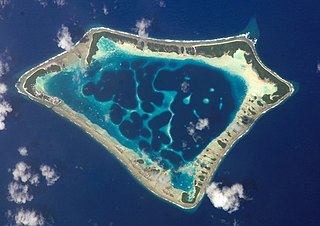| Geography | |
|---|---|
| Location | Saginaw Bay |
| Coordinates | 44°00′09″N83°27′58″W / 44.00250°N 83.46611°W Coordinates: 44°00′09″N83°27′58″W / 44.00250°N 83.46611°W |
| Area | 5.4 acres (2.2 ha) |
| Administration | |
| State | Michigan |
| County | Arenac County |
| Township | Sims Township |
| Demographics | |
| Population | Uninhabited |
Little Charity Island is a small island in Saginaw Bay, Lake Huron. The 5.4-acre (0.02 km2) island is located in Sims Township, Arenac County in the U.S. state of Michigan. Acquired by the U.S. Fish and Wildlife Service in 1999, it is administered by staff from the Seney National Wildlife Refuge as a unit of the Michigan Islands National Wildlife Refuge.

An island or isle is any piece of sub-continental land that is surrounded by water. Very small islands such as emergent land features on atolls can be called islets, skerries, cays or keys. An island in a river or a lake island may be called an eyot or ait, and a small island off the coast may be called a holm. A grouping of geographically or geologically related islands is called an archipelago, such as the Philippines.

Saginaw Bay is a bay within Lake Huron located on the eastern side of the U.S. state of Michigan. It forms the space between Michigan's Thumb region and the rest of the Lower Peninsula of Michigan. Saginaw Bay is 1,143 square miles (2,960 km2) in area. It is located in parts of five Michigan counties: Arenac, Bay, Huron, Iosco, and Tuscola.

Lake Huron is one of the five Great Lakes of North America. Hydrologically, it comprises the easterly portion of Lake Michigan–Huron, having the same surface elevation as its westerly counterpart, to which it is connected by the 5-mile-wide (8.0 km), 20-fathom-deep Straits of Mackinac. It is shared on the north and east by the Canadian province of Ontario and on the south and west by the state of Michigan in the United States. The name of the lake is derived from early French explorers who named it for the Huron people inhabiting the region. The Huronian glaciation was named due to evidence collected from Lake Huron region. The northern parts of the lake include the North Channel and Georgian Bay. Across the lake to the southwest is Saginaw Bay. The main inlet is the St. Marys River, and the main outlet is the St. Clair River.
Little Charity Island is located in the middle of the bay, inland from its larger neighbor, Big Charity Island. It rises approximately halfway between "Point Lookout" to the northwest and "Sand Point" to the southeast. The island is home to some riparian tree life, and is home to colonial-nesting waterbirds, including double-crested cormorants. Many bay fishermen use the island as a navigation point.

Charity Island, sometimes called Big Charity Island, is the largest island in Saginaw Bay, in the Michigan waters of Lake Huron. The island is 222 acres (0.90 km2) in area and has about 3 miles (4.8 km) of shoreline. It is part of Whitney Township, in Arenac County.

The double-crested cormorant is a member of the cormorant family of seabirds. Its habitat is near rivers and lakes as well as in coastal areas, and is widely distributed across North America, from the Aleutian Islands in Alaska down to Florida and Mexico. Measuring 70–90 cm (28–35 in) in length, it is an all-black bird which gains a small double crest of black and white feathers in breeding season. It has a bare patch of orange-yellow facial skin. Five subspecies are recognized. It mainly eats fish and hunts by swimming and diving. Its feathers, like those of all cormorants, are not waterproof and it must spend time drying them out after spending time in the water. Once threatened by the use of DDT, the numbers of this bird have increased markedly in recent years.

Navigation is a field of study that focuses on the process of monitoring and controlling the movement of a craft or vehicle from one place to another. The field of navigation includes four general categories: land navigation, marine navigation, aeronautic navigation, and space navigation.
Little Charity Island was once called Ile de Traverse, according to an 1839 map of Michigan. [1] In the 19th century and early 20th century Little Charity was owned by Bay Port Fish Company, a commercial fishing company in Saginaw Bay, for its riparian water rights. After the 1940s, when Michigan law changed, the island was sold as were other islands in the bay.[ citation needed ]
Riparian water rights is a system for allocating water among those who possess land along its path. It has its origins in English common law. Riparian water rights exist in many jurisdictions with a common law heritage, such as Canada, Australia, and states in the eastern United States.











